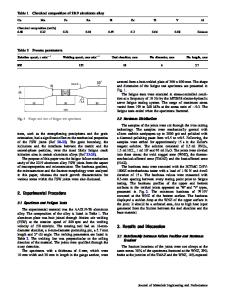Surface and mechanical characterization of stationary shoulder friction stir welded lap joints: experimental and numeric
- PDF / 1,778,929 Bytes
- 12 Pages / 595.276 x 790.866 pts Page_size
- 8 Downloads / 277 Views
IJMF 10TH ANNIVERSARY - ADVANCES IN MATERIAL FORMING
Surface and mechanical characterization of stationary shoulder friction stir welded lap joints: experimental and numerical approach Gianluca Buffa 1 & Livan Fratini 1 & Filomena Impero 2 & Attilio Masnata 1 & Fabio Scherillo 2 & Antonino Squillace 2 Received: 11 July 2019 / Accepted: 11 June 2020 # Springer-Verlag France SAS, part of Springer Nature 2020
Abstract Friction Stir Welding (FSW) is one of the most used solid-state welding processes in the aeronautical, aerospace, ground transportation and naval fields. Stationary Shoulder Friction Stir Welding (SSFSW) is a recently introduced variant of the process allowing lower heat input into the joints, with beneficial effects in terms of joint mechanical properties, microstructure and top surface finish. In the paper, lap joints produced by SSFSW and made out of AA6082-T6 aluminum alloy sheets have been analyzed with the aim to investigate the effect of the stationary shoulder on the lap joints surface, metallurgical, and mechanical properties. The lap joints produced by SSFSW have been compared to the ones produced by “conventional” FSW in order to highlight the differences between the two processes. The top surface of the joints obtained with the two processes has been quantitatively evaluated. Finally, a dedicated numerical model has been utilized to highlight the causes of the observed differences through the distributions of the main field variables, namely temperature, strain and strain rate. It was found that SSFSW results in narrower weld nugget and smaller areas involved by micro hardness reduction caused by smaller peak temperature and high temperature zone. Additionally, better surface quality was found for the joint welded by SSFSW with lower heights and flash, allowing to avoid subsequent finishing operations needed for most industrial applications. Keywords Friction Stir Welding . Stationary Shoulder . FEM . Roughness . Microstructure
Introduction Friction Stir Welding (FSW) is now a well-known solid-state welding process used to produce joints of different materials and morphologies. Since the process was first developed and patented by TWI in 1991, its several advantages with respect to traditional fusion welding processes, i.e. the possibility to weld “non-weldable” or “difficult to weld” materials, the absence of porosities, inclusions and fumes, the low distortions and residual stresses as well as the fact it can be considered a green process, have attracted the attention of both industry and academia. In the years between 1993 and 2014, more than
* Gianluca Buffa [email protected] 1
Department of Industrial and Digital Innovation, University of Palermo, Viale delle Scienze, 90128 Palermo, Italy
2
Department of Chemical, Materials and Industrial Production Engineering, University of Naples Federico II, Piazzale Tecchio 80, 80125 Naples, Italy
3,000 patents were published by industry, mainly in the transportation sector, while a continuously growing number of papers has been publis
Data Loading...











